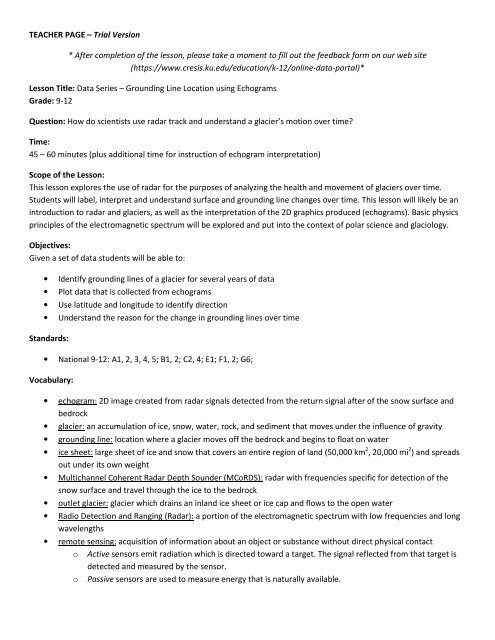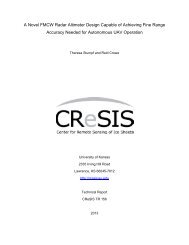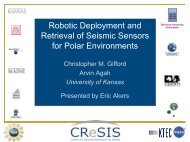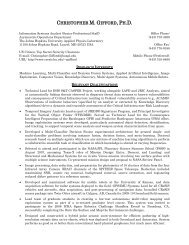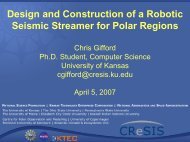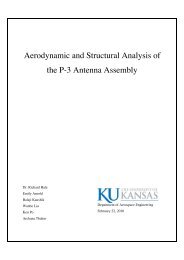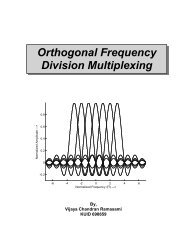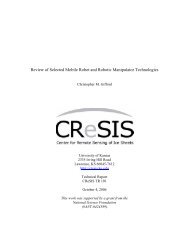Grounding Line Location using Echograms - CReSIS
Grounding Line Location using Echograms - CReSIS
Grounding Line Location using Echograms - CReSIS
You also want an ePaper? Increase the reach of your titles
YUMPU automatically turns print PDFs into web optimized ePapers that Google loves.
TEACHER PAGE – Trial Version<br />
* After completion of the lesson, please take a moment to fill out the feedback form on our web site<br />
(https://www.cresis.ku.edu/education/k-12/online-data-portal)*<br />
Lesson Title: Data Series – <strong>Grounding</strong> <strong>Line</strong> <strong>Location</strong> <strong>using</strong> <strong>Echograms</strong><br />
Grade: 9-12<br />
Question: How do scientists use radar track and understand a glacier’s motion over time?<br />
Time:<br />
45 – 60 minutes (plus additional time for instruction of echogram interpretation)<br />
Scope of the Lesson:<br />
This lesson explores the use of radar for the purposes of analyzing the health and movement of glaciers over time.<br />
Students will label, interpret and understand surface and grounding line changes over time. This lesson will likely be an<br />
introduction to radar and glaciers, as well as the interpretation of the 2D graphics produced (echograms). Basic physics<br />
principles of the electromagnetic spectrum will be explored and put into the context of polar science and glaciology.<br />
Objectives:<br />
Given a set of data students will be able to:<br />
• Identify grounding lines of a glacier for several years of data<br />
• Plot data that is collected from echograms<br />
• Use latitude and longitude to identify direction<br />
• Understand the reason for the change in grounding lines over time<br />
Standards:<br />
• National 9-12: A1, 2, 3, 4, 5; B1, 2; C2, 4; E1; F1, 2; G6;<br />
Vocabulary:<br />
• echogram: 2D image created from radar signals detected from the return signal after of the snow surface and<br />
bedrock<br />
• glacier: an accumulation of ice, snow, water, rock, and sediment that moves under the influence of gravity<br />
• grounding line: location where a glacier moves off the bedrock and begins to float on water<br />
• ice sheet: large sheet of ice and snow that covers an entire region of land (50,000 km 2 , 20,000 mi 2 ) and spreads<br />
out under its own weight<br />
• Multichannel Coherent Radar Depth Sounder (MCoRDS): radar with frequencies specific for detection of the<br />
snow surface and travel through the ice to the bedrock<br />
• outlet glacier: glacier which drains an inland ice sheet or ice cap and flows to the open water<br />
• Radio Detection and Ranging (Radar): a portion of the electromagnetic spectrum with low frequencies and long<br />
wavelengths<br />
• remote sensing: acquisition of information about an object or substance without direct physical contact<br />
o Active sensors emit radiation which is directed toward a target. The signal reflected from that target is<br />
detected and measured by the sensor.<br />
o Passive sensors are used to measure energy that is naturally available.
Background:<br />
Ice sheets, such as those found in Greenland and Antarctica play an important role in a number of Earth systems. <strong>CReSIS</strong><br />
is especially interested in their role of changing sea levels. An ice sheet is formed when large amounts of snow<br />
accumulate over time, and under its own weight begins to compress into ice and spread out over the land. In some cases<br />
this ice is trapped by come geologic features such as a mountain range. In other cases, this ice is able to flow through<br />
breaks in these mountains, flowing through valleys as glaciers, and eventually reaching the open water. These are called<br />
outlet glaciers, and are the primary way ice from the interior of an ice sheet reaches the ocean. Through information<br />
about ice thickness and where the ice begins to float as it approaches the ocean (the grounding line), it is possible gain<br />
knowledge about the amount of water displaced from the ice and its role in sea level changes (Figure 1). <strong>CReSIS</strong> is<br />
generally interested in the ice thickness and location of the grounding line<br />
for the purposes modeling sea level rise. Depending on how much ice exists<br />
and how quickly it is reaching the ocean, it is possible to estimate how<br />
much sea level may change in the future.<br />
Figure 1 - Illustration showing various stages of a<br />
grounded glacier. The grounding line is the location<br />
where the bedrock, bottom of the glacier, and<br />
water meet.<br />
<strong>CReSIS</strong> measures ice sheet thickness by flying radar sensors mostly over<br />
regions of Antarctica and Greenland with the purpose of <strong>using</strong> the<br />
information to better model the amount of ice on Earth and how it changes<br />
over time. This is important in the study of glaciers, sea level rise, and<br />
climate change. <strong>CReSIS</strong> radar data are collected via airborne platforms with<br />
the radar attached to the wings and/or belly of an aircraft. Radar is an<br />
active sensor in which signals are sent out (transmitted) and returned by<br />
reflection off an object. These return signals are detected (absorbed) and<br />
processed to produce a two-dimensional image (echogram). <strong>Echograms</strong><br />
contain data about locations and depths of bedrock or water under the<br />
surface of the ice sheets. There are many types of radar that can be<br />
attached to an aircraft depending on the science interests. The Multichannel<br />
Coherent Radar Depth Sounder (MCoRDS) is a type of radar that is<br />
best used for collecting information about the bedrock.<br />
Students will interpret several echograms to locate and record the<br />
groundling line for a glacier in Greenland. Using Google Earth, students will<br />
plot the location of the grounding line from two different years and analyze<br />
how the grounding line position has changed. Students will not only learn<br />
how to interpret an echogram, but also study glacier processes and use data collected to understand why the glacier<br />
behaved a certain way.<br />
Materials:<br />
• Computer with Internet and Google Earth<br />
• Echogram Background<br />
• Petermann Glacier (Greenland) echograms (<strong>Grounding</strong><strong>Line</strong>_Teacher.pdf – this document contains all the<br />
imagery discussed in this lesson along with answer keys and examples)<br />
• Student Worksheet (optional)<br />
Engage (for students without any glaciology background):<br />
• <strong>CReSIS</strong> Ice, Ice Baby lessons (https://www.cresis.ku.edu/education/k-12/ice-ice-baby-lessons)<br />
o How do Ice Sheets Form?
o How is Glacier Goo Similar to a Real Glacier?<br />
Engage (for students with some glaciology background):<br />
• Complete an Internet search for glacier and ice sheet images<br />
• Make a few predictions about glacial processes (formation, movement, etc.)<br />
Q1) Sketch a glacier and label several parts.<br />
Q2) What part of a glacier do you predict to flow the fastest? What may cause a glacier to speed up?<br />
Q3) Give an example of a method or technology that researchers use to collect data about glaciers.<br />
Explain:<br />
Explore the ‘Echogram Background’ document. Make sure you are familiar with all the necessary information.<br />
• Discuss different characteristics and features of the echogram and how to interpret.<br />
This particular echogram was from the 2003 Greenland field campaign flown over Petermann Glacier in NW Greenland.<br />
Q4) What characteristics of a glacier do you see in this echogram?<br />
Q5) Describe how are you able to identify each characteristic?<br />
Q6) Estimate the latitude and longitude of the grounding line.<br />
Q7) What direction is the platform carrying the radar flying?<br />
Explore:<br />
• Using the Petermann Glacier echograms (PDF), first estimate the<br />
approximate location of the groundling line from each of the two<br />
2003 images and record in Table 1. Plot these coordinates in Google<br />
Earth (Figure 2).<br />
• Draw a line across the glacier connecting the two points of your<br />
estimated grounding line.<br />
• Plot the coordinates from the x-axis of the echogram and<br />
determine which direction the plane was flying and record in Table<br />
1. Make sure to carefully label the points from each echogram so as to not confuse them with other years.<br />
• Repeat for each of the two 2007 images. You should have a total of 28 coordinates plotted.<br />
Table 1 - Fill in coordinates for estimated grounding line locations.<br />
2003 A<br />
2003 B<br />
2007 A<br />
2007 B<br />
Figure 2 - Coordinates from 2003A plotted in<br />
Google Earth.<br />
Latitude Longitude Flight Direction
Q8) Do the grounding lines fall between the flight lines? If not recalculate your estimated grounding line<br />
Q9) Briefly describe the changes you observe in the location of the grounding line in 2003, 2007.<br />
Q10) Briefly explain how you determined the flight path direction for the data collected for each echogram.<br />
*NOTE* A *.kmz (Google Earth) file has been included with all of the data points plotted for your reference. It also<br />
includes estimated grounding lines drawn for each of the three years (2003, 2007, and 2011).<br />
Explain:<br />
Display the scientist’s estimations for the grounding<br />
line (Figure 3) and have students compare their results.<br />
The most common error will be drawing the actual line<br />
connecting the grounding line points. Because<br />
grounding line interpretations are only an estimate<br />
from the echogram (<strong>using</strong> only two echograms<br />
resulting in two estimates of position), this step is<br />
subject to a fairly high degree of error due to personal<br />
analysis. As long as there is a difference in the<br />
grounding line positions between 2003 and 2007 and<br />
the 2007 line is located to the NW (above and to the<br />
left) of the 2003 line, then the result is acceptable for<br />
further discussion.<br />
Q11) Does the location of your estimated grounding<br />
lines look the same as the Petermann Glacier<br />
<strong>Grounding</strong> <strong>Line</strong> Map (Figure 3)? If not, what are some<br />
possible sources of error?<br />
Q12) Why would it be important for researchers to record this type of data over several years?<br />
Extend:<br />
Figure 3 - Scientists accepted grounding line locations from 2003 and 2007<br />
echogram data.<br />
• The migration of grounding lines provides some indication of the stability and health of a glacier; if it is<br />
advancing, the glacier is getting thicker and growing; if the grounding line is retreating, the glacier is thinning<br />
and likely accelerating.<br />
• Glaciers that have recently accelerated and thinned are transporting more ice into the ocean with grounding<br />
lines that are migrating inland (retreating).<br />
The northern part of Petermann Glacier experienced many dramatic changes in 2009 and 2010. Scientists have recorded<br />
images or video of the great glacier break-off from August 2010.<br />
• View the following videos related to Petermann Glacier.<br />
o Byrd Polar Research Center: http://bprc.osu.edu/wiki/Petermann_Glacier_before-after-photos_2010-<br />
2011<br />
o Discovery News: http://news.discovery.com/videos/news-arctic-melt-caught-on-video.html<br />
o Earth Observatory: http://earthobservatory.nasa.gov/NaturalHazards/view.php?id=45112<br />
• Recently processed 2011 data is now available on the <strong>CReSIS</strong> web site. A couple of images have been included<br />
on the ‘Petermann Glacier’ PDF.
• Go through the same processes outlined above to determine the grounding line in 2011.<br />
Q13) How has the grounding line changed position since 2007? 2003?<br />
Evaluate:<br />
Provide a copy of a blank echogram (Figure 4) and have the students respond to the following questions/tasks.<br />
• Using a blank echogram, respond to the following questions/tasks:<br />
Q14) Trace and describe the snow surface and bedrock echo lines.<br />
Q15) Approximate the grounding line latitude and longitude and draw it on the echogram.<br />
Q16) Describe the general flight path of the plane over the glacier and the physical features of the glacier along this<br />
path.<br />
Q17) Suggest why an echogram would be important to a glaciologist.<br />
Related Activities:<br />
• Data Series – Ice Thickness (https://www.cresis.ku.edu/education/k-12/online-data-portal)<br />
Resources:<br />
Center for Remote Sensing of Ice Sheets. 2011. Data Products. https://data.cresis.ku.edu/data/rds/.
STUDENT PAGE<br />
Lesson Title: Data Series – <strong>Grounding</strong> <strong>Line</strong> <strong>Location</strong> <strong>using</strong> <strong>Echograms</strong><br />
Question: How do scientists use radar track and understand a glacier’s motion over time?<br />
Objectives:<br />
Given a set of data students will be able to:<br />
• Identify grounding lines of a glacier for several years of data<br />
• Plot data that is collected from echograms<br />
• Use latitude and longitude to identify direction<br />
• Understand the reason for the change in grounding lines over time<br />
Vocabulary:<br />
• echogram: __________________________________________________________________________________<br />
• glacier: _____________________________________________________________________________________<br />
• grounding line: _______________________________________________________________________________<br />
• ice sheet: ___________________________________________________________________________________<br />
• Multichannel Coherent Radar Depth Sounder (MCoRDS):<br />
___________________________________________________________________________________________<br />
• outlet glacier: ________________________________________________________________________________<br />
• Radio Detection and Ranging (Radar):<br />
___________________________________________________________________________________________<br />
• remote sensing: ______________________________________________________________________________<br />
o Active sensors _________________________________________________________________________<br />
o Passive sensors ________________________________________________________________________<br />
Background:<br />
Ice sheets, such as those found in Greenland and Antarctica play an<br />
important role in a number of Earth systems. <strong>CReSIS</strong> is especially<br />
interested in their role of changing sea levels. An ice sheet is formed when<br />
large amounts of snow accumulate over time, and under its own weight<br />
begins to compress into ice and spread out over the land. In some cases<br />
this ice is trapped by come geologic features such as a mountain range. In<br />
other cases, this ice is able to flow through breaks in these mountains,<br />
flowing through valleys as glaciers, and eventually reaching the open<br />
water. These are called outlet glaciers, and are the primary way ice from<br />
the interior of an ice sheet reaches the ocean. Through information about<br />
ice thickness and where the ice begins to float as it approaches the ocean<br />
(the grounding line), it is possible gain knowledge about the amount of<br />
water displaced from the ice and its role in sea level changes. <strong>CReSIS</strong> is<br />
generally interested in the ice thickness and location of the grounding line<br />
for the purposes modeling sea level rise. Depending on how much ice<br />
exists and how quickly it is reaching the ocean, it is possible to estimate<br />
how much sea level may change in the future.<br />
Figure 4 – Illustration showing various stages of a<br />
grounded glacier. The grounding line is the location<br />
where the bedrock, bottom of the glacier, and<br />
water meet.
<strong>CReSIS</strong> measures ice sheet thickness by flying radar sensors mostly over regions of Antarctica and Greenland with the<br />
purpose of <strong>using</strong> the information to better model the amount of ice on Earth and how it changes over time. This is<br />
important in the study of glaciers, sea level rise, and climate change. <strong>CReSIS</strong> radar data are collected via airborne<br />
platforms with the radar attached to the wings and/or belly of an aircraft. Radar is an active sensor in which signals are<br />
sent out (transmitted) and returned by reflection off an object. These return signals are detected (absorbed) and<br />
processed to produce a two-dimensional image (echogram). <strong>Echograms</strong> contain data about locations and depths of<br />
bedrock or water under the surface of the ice sheets. There are many types of radar that can be attached to an aircraft<br />
depending on the science interests. The Multi-channel Coherent Radar Depth Sounder (MCoRDS) is a type of radar that<br />
is best used for collecting information about the bedrock.<br />
Materials:<br />
• Computer with Internet and Google Earth<br />
• Echogram Background<br />
• Petermann Glacier (Greenland) echograms (<strong>Grounding</strong><strong>Line</strong>_Student.pdf)<br />
• Student Worksheet (optional)<br />
Engage (for students without any glaciology background):<br />
• <strong>CReSIS</strong> Ice, Ice Baby lessons (https://www.cresis.ku.edu/education/k-12/ice-ice-baby-lessons)<br />
o How do Ice Sheets Form?<br />
o How is Glacier Goo Similar to a Real Glacier?<br />
Engage (for students with some glaciology background):<br />
• Complete an Internet search for glacier and ice sheet images<br />
• Make a few predictions about glacial processes (formation, movement, etc.)<br />
Q1) Sketch a glacier and label several parts.<br />
Q2) What part of a glacier do you predict to flow the fastest? What may cause a glacier to speed up?<br />
Q3) Give an example of a method or technology that researchers use to collect data about glaciers.<br />
Explain:<br />
Q4) What characteristics of a glacier do you see in this echogram?<br />
Q5) Describe how are you able to identify each characteristic?<br />
Q6) Estimate the latitude and longitude of the grounding line.<br />
Q7) What direction is the platform carrying the radar flying?<br />
Explore:<br />
• Using the Petermann Glacier echograms (PDF), first estimate the<br />
approximate location of the groundling line from each of the two<br />
2003 images and record in Table 1. Plot these coordinates in Google<br />
Earth (Figure 2).<br />
Figure 2 – Coordinates from 2003A plotted in<br />
Google Earth.<br />
• Draw a line across the glacier connecting the two points of your estimated grounding line.
• Plot the coordinates from the x-axis of the echogram and determine which direction the plane was flying and<br />
record in Table 1. Make sure to carefully label the points from each echogram so as to not confuse them with<br />
other years.<br />
• Repeat for each of the two 2007 images. You should have a total of 28 coordinates plotted.<br />
Table 2 - Fill in coordinates for estimated grounding line locations.<br />
2003 A<br />
2003 B<br />
2007 A<br />
2007 B<br />
Q8) Do the grounding lines fall between the flight lines? If<br />
not recalculate your estimated grounding line<br />
Q9) Briefly describe the changes you observe in the location<br />
of the grounding line in 2003, 2007.<br />
Q10) Briefly explain how you determined the flight direction<br />
for the data collected for each echogram.<br />
Explain:<br />
Q11) Does the location of your estimated grounding lines<br />
look the same as the Petermann Glacier <strong>Grounding</strong> <strong>Line</strong> Map<br />
(Figure 3)? If not, what are some possible sources of error?<br />
Q12) Why would it be important for researchers to record<br />
this type of data over several years?<br />
Extend:<br />
Latitude Longitude Flight Direction<br />
The northern part of Petermann Glacier experienced many dramatic changes in 2009 and 2010. Scientists have recorded<br />
images or video of the great glacier break-off from August 2010.<br />
• View the following videos related to Petermann Glacier.<br />
o Byrd Polar Research Center: http://bprc.osu.edu/wiki/Petermann_Glacier_before-after-photos_2010-<br />
2011<br />
o Discovery News: http://news.discovery.com/videos/news-arctic-melt-caught-on-video.html<br />
o Earth Observatory: http://earthobservatory.nasa.gov/NaturalHazards/view.php?id=45112<br />
• Recently processed 2011 data is now available on the <strong>CReSIS</strong> web site. A couple of images have been included<br />
on the ‘Petermann Glacier’ PDF.<br />
• Go through the same processes outlined above to determine the grounding line in 2011.<br />
Q13) How has the grounding line changed position since 2007? 2003?<br />
Figure 3 – Scientists accepted grounding line locations from 2003 and<br />
2007 echogram data.
Evaluate:<br />
• Using a blank echogram, respond to the following questions/tasks:<br />
Q14) Trace and describe the snow surface and bedrock echo lines.<br />
Q15) Approximate the grounding line latitude and longitude and draw it on the echogram.<br />
Q16) Describe the general flight path of the plane over the glacier and the physical features of the glacier along this<br />
path.<br />
Q17) Suggest why an echogram would be important to a glaciologist.
ANSWER KEY<br />
Q1) Figure 4 is illustrates just some of the possible features students may label. Depending on their diagram, they may<br />
have other features labeled such as moulins, crevasses, margins, ablation zone, accumulation zone, etc. Another more<br />
complete diagram of a glacier can be obtained from Indiana University<br />
(http://www.indiana.edu/~sierra/papers/2008/gray_clip_image002.jpg).<br />
Figure 4 - Basic glacier features (from <strong>CReSIS</strong> 'Glaciers in Motion' project)<br />
Q2) Answers will vary. The center part of the glacier should flow the fastest as there is less friction with the margins or<br />
sides of the glaciers (mountains). A glacier may speed up if the surface slope changes or if water reaches the bed and<br />
helps to reduce friction between the bottom of the glacier and the bedrock.<br />
Q3) Researchers can use a variety of technologies from GPS units placed on the actual glacier to monitor motion to the<br />
radar technologies mentioned in the background of this lesson. For radar, electromagnetic signals are sent from an<br />
airborne platform and the reflections from various surfaces (snow surface, bedrock, water, etc.) are detected.<br />
Q4) This echogram illustrates the snow surface, bedrock, ice, water, and the grounding line. You can also see the<br />
coordinates along the flight path indicating the direction of flight.<br />
Q5) The snow surface is the initial reflection. The bedrock is the dark reflection towards the middle to bottom of the<br />
echogram, visible underneath the snow surface line. This is typically more jagged than the snow surface. The grounding<br />
line can be determined as the location where the bedrock echo is distorted and blurry by the reflection of the radar<br />
signal by water.<br />
Q6) ~80.5° N, 60.4° W. The coordinates should fall between 80.407° N and 80.605° N, and 59.754° W and 60.759° W.<br />
Q7) The plane is flying to the northwest, from the interior of Greenland, along Petermann Glacier.
Table 3 - Approximation of estimated grounding line coordinates.<br />
Latitude Longitude Flight Direction<br />
2003 A 80.55° N 59.90° W NW<br />
2003 B 80.57° N 59.80° W SE<br />
2007 A 80.58° N 59.89° W NW<br />
2007 B 80.60° N 60.05° W SE<br />
Q8) The coordinates for the grounding line should fall between the coordinates plotted from the x-axis of the echogram.<br />
See Figure 5 for the data from 2003 A.<br />
Figure 5 - Estimated grounding line position, 2003 A<br />
Q9) The location of the 2007 grounding line is located to the NW of the 2003 grounding line. This indicated an advance<br />
of the grounding line, which could signify a mostly healthy glacier.
Q10) By plotting the coordinates from the x-axis of the echograms, it is possible to determine the flight path of the<br />
plane. Also, the distance increases from the first set of coordinates to the last set, making it possible to determine flight<br />
direction from simply plotting those two points.<br />
Q11) Answers will vary. Accept all reasonable answers where the student accurately describes the results of their<br />
grounding line estimations compared to the accepted location found by scientists.<br />
Q12) Since the location of the grounding line is a rough indication of the health of a glacier, collecting this data over<br />
multiple years will allow scientists to monitor how a glacier is behaving over time. The results of this data can also lead<br />
to improved models to predict future changes in sea level.<br />
Q13) The grounding line position appears to have retreated slightly since 2007, and also it has smoothed out. The line<br />
still appears to the NW of the 2003 line. (Remember, these are estimates of grounding line position and are only based<br />
on two samples for each year)<br />
Figure 6 - Estimate grounding location; 2003 in green, 2007 in blue, and 2011 in orange<br />
Q14) See Figure 7
Q15) See Figure 7<br />
Figure 7 - Diagram labels for questions 14 and 15<br />
Q16) The plane is flying to the NW from the interior of Greenland across Petermann Glacier. The glacier is getting<br />
thinner as the plane moves to the northwest and moves closer to the open water. This it to be expected as glaciers are<br />
thickest near the interior and thin as you move towards the terminus.<br />
Q17) Refer to question 12.


